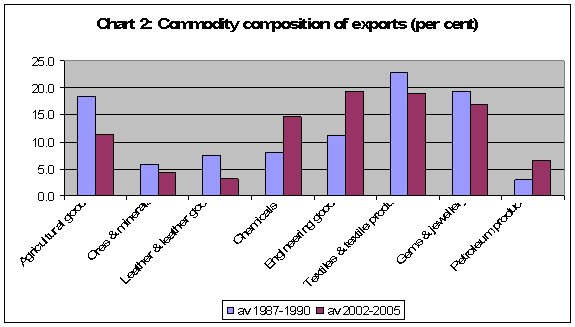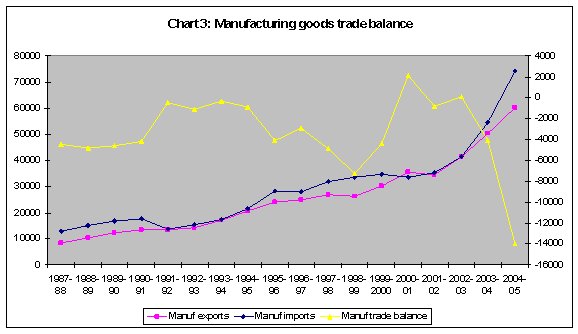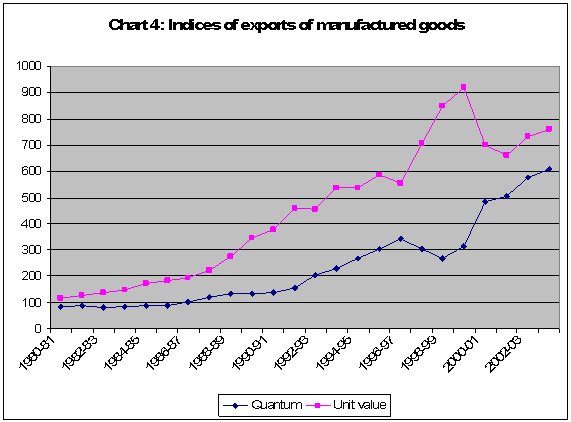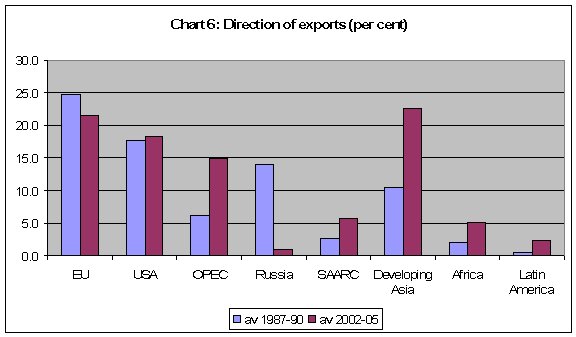Economic
reforms since 1991 have been strongly associated with
external trade liberalisation. As officially stated,
the chief purpose of this was to bring domestic relative
prices into line with world prices, thereby supposedly
creating conditions for greater efficiency and competitiveness
of domestic production. This in turn was supposed
to generate more rapid increases in exports, which
were then expected to shift the economy towards more
labour-intensive forms of production.
Until
a few years ago, it seemed that these expectations
were not met, as the rate of growth of exports (in
US dollar terms) in the 1990s was only marginally
higher than that of the 1980s, and significantly lower
than in the ''closed economy'' days of the 1970s.
However, very recent increases in export growth since
2001, resulting in rates of export expansion of around
20 per cent per year and increases in India's (admittedly
small) share of world trade, have created great optimism
about export potential.
As Chart 1 shows, exports have indeed increased at
a relatively rapid rate in the very recent past. However,
it should be noted that imports have increased at
an even more rapid rate, so that the aggregate trade
balance has deteriorated very sharply, and in the
current year it is estimated to cross $30 billion.
(The increase in import values is usually blamed on
oil prices; however, non-oil imports have increased
at an even more rapid rate in value terms. Trends
in imports will be examined in a subsequent MacroScan.)

Chart
1 >> Click
to Enlarge
What is interesting about the recent export expansion
is that it also marks a further diversification in
terms of commodity composition, in rather unexpected
ways. Chart 2 compares the two periods 1987-88 to
1989-90 and 2002-03 to 2004-05.
The process of global integration and the effects
of the WTO agreements were expected to cause particular
increases in India's exports of agricultural goods,
textiles and garments, leather and gems and jewellery.
However, it is apparent that all of these categories
have actually declined in share of exports. Instead,
chemicals and engineering goods show substantial increases
in export shares. The other surprise comes in the
export of petroleum goods, when the thrust of Indian
policy has been to increase domestic processing of
such material for domestic consumption.

Chart
2 >> Click
to Enlarge
Clearly, therefore, the important thrust in exports
has come from certain categories of manufacturing
goods. Overall, however, even the manufacturing trade
balance gone increasingly into deficit in recent years,
as Chart 3 indicates. From a surplus in 2000-01 (which
is incidentally a year of relatively poor performance
in exports) and balance in 2002-03, the manufactured
goods trade deficit alone was more than $14 billion
in 2004-05.

Chart
3 >> Click
to Enlarge
However, it is certainly the case that manufacturing
exports have increased quite sharply since 2000-01,
and so this deserves further examination. Chart 4
shows that this has not necessarily been the result
of massive undercutting in price terms, at least as
far as overall manufacturing exports are concerned.
While some degree of inverse relationship is apparent
between the quantity of export and the unit values,
in general there is an increasing trend for both.
Also, while the unit values have not reached the peaks
achieved in the late 1990s, the period after 2000,
both the quantum index and the unit value index have
been rising.

Chart
4 >> Click
to Enlarge
This is certainly good news, and if it suggests that
Indian manufacturing has reached a new stage where
it is internationally competitive without having to
resort to major price competition, then it is even
better news. But to come to such an assessment we
would need to examine the patterns of exports more
closely in terms of which commodities are showing
the most rapid increase.
As we have already noted from Chart 2, even in manufacturing,
the recent increase has not come from those sectors
which were expected to benefit from greater openness,
such as textiles and garments and gems and jewellery,
which have declined in terms of share of total exports.
Rather, engineering goods and chemical products have
emerged as the biggest gainers in recent times. It
is therefore worth examining the composition of engineering
goods exports, to see which have been the dynamic
sectors.
Chart 5 provides a glimpse into exports of various
categories of engineering goods since 1987, in terms
of millions of US dollars. This provides an interesting
picture which is somewhat at variance with the image
that is sought to be created by current press reports.

Chart
5 >> Click
to Enlarge
It is generally thought, for example, that the recent
increase in exports is because of greater exports
by the automobile sector, as India emerges as one
of the developing country car exporters based on local
assembly using components made here but mostly abroad.
However, in fact India remains one of the small exporters
in this area, although clearly there may be scope
for expansion here. In fact, as Chart 5 shows, while
exports of transport equipment have increased in recent
years, this increase has not been all that dramatic.
In fact, the share of transport equipment in total
engineering goods exports has come down from an average
of 21 per cent in the mid-1990s to 15 per cent in
the most recent three-year period.
This is also true of exports of electronic goods,
whose share in the engineering exports category has
come down from an average of 15 per cent to around
11 per cent in the most recent period. The share of
machinery and instrument has remained broadly stable
at around 22 per cent.
The biggest increase – and the real source of the
recent expansion in aggregate export increases in
this sector – has come from iron and steel, which
has increased its share of exports in this sector
from just 7 per cent at the start of the 1990s to
15 per cent in the mid 1990s to 22 per cent in the
most recent period. This reflects the recent surge
in demand for steel worldwide, which is the result
of large demand emanating from China in particular.
The other important exporting sector is metal manufactures,
and here too the export increase is the result of
changing conditions in the world market.
Significantly, therefore, the bulk of the increase
in ''engineering goods'' exports is accounted for
by exports of bulk intermediates like steel which
are going to booming East Asian markets. This may
or may nor reflect enhanced industrial competitiveness
of India in general – certainly on the basis of this
evidence alone, it would be hard to come to such a
conclusion.
The pattern is corroborated by changes in India's
direction of trade in the recent past, as shown in
Chart 6. Between the late 1980s and the most recent
three-year period, there have been substantial shifts
in the direction of exports. While the US had broadly
maintained its share of around 18 per cent of India's
exports, there is evidence of some shifts and substantial
geographical diversification in terms of other regions.

Chart
6 >> Click
to Enlarge
The largest decline, predictably, is in exports to
Russia, whose share has fallen from 14 per cent to
only 1 per cent. But even the European Union is less
significant, and other developing countries have emerged
as more significant markets. The good news is that
Africa and Latin America have emerged as export markets
of some significance, unlike in the past.
The biggest increase is to other developing countries
in Asia, most particularly PR China, Hong Kong China
and Singapore. Since the latter two are essentially
zones of re-export within the region, exports to these
two areas reflects the growing pattern of intra-regional
trade based on industrial relocation through geographically
dispersed production, as well as the growing demand
for raw materials and intermediates emanating from
East Asia in general.
Of these, by far the most significant is China. While
India currently has a trade deficit with China, from
where final manufactured goods are imported into the
country, it has a reasonably large trade surplus with
Hong Kong, which routes many of these exports through
to mainland China. It has a similarly large trade
surplus with Singapore, which is also dominantly a
re-exporter to the region and elsewhere. Of course
it is good news that India is getting integrated to
these production chains in Asia; the only concern
here is that these chains themselves are still ultimately
dependent upon demand from the US which still acts
as the basic engine of growth for East Asia.
Clearly, therefore, important changes are taking place
in both the rate and pattern of India's exports. However,
the evidence thus far is not enough to allow for the
conclusion that there has been a significant increase
in India's external competitiveness. In fact, since
so much of the export growth has come from iron and
steel and chemical products, it may just reflect the
greater dynamism of other economies in East Asia which
are importing these at more rapid rates.

